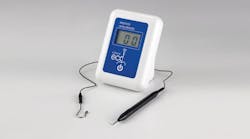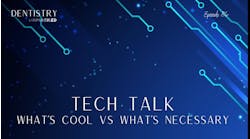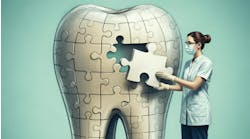Pearls for Your Practice: Ortek-ECD caries detection device
Once every couple of weeks, I will have a new patient come in for a second opinion. Many times, those second opinions involve difficult conversations with a patient about why different dentists diagnose things differently.
Many patients assume that there is some sort of metric or data that we apply to our analysis of carious lesions. I explain to them that every clinician has different philosophies and backgrounds that affect our judgment of suspected caries, in addition to the patient’s risk and previous dentistry. It is not an easy conversation and it makes me wish for something more analytical. Due to these types of experiences and hidden camera media reports, patients are more skeptical than ever. Having tools to help remove some of this mystery for patients can help our patients trust us . . . and when it comes to treatment acceptance, trust means yes.
Ortek-ECD is a device invented just for this. ECD stands for Electronic Caries Detection. It is designed to detect occlusal cavitated lesions at the earliest possible stage by measuring the conductivity of the enamel. As a carious lesion begins, fluid from the dentin can seep up into the lesion. The Ortek-ECD detects this fluid and gives a score reading. A score of 0 is indicative of sound enamel. A score of 1 usually means that decay has extended into enamel and possibly through to the dentinoenamel junction. A score of 2 and above means dentinal involvement in the lesion. Basically a 0 means no intervention necessary. A 1 means possible intervention needed. Anything above that means it’s definitely time to intervene. This gives us evidence that we can share with patients in regard to their potential carious lesions.
The Ortek-ECD is small, handheld, and easy to use. Its setup is similar to an apex locator. It requires a completed circuit to give an accurate reading. There is a lip hook and a probe that must plug into the Ortek-ECD unit. Simply plug the lip hook and probe cord into the Ortek-ECD; then apply the lip hook to the patient’s lip. Dry the tooth you want to test and then run the probe through the fissure system. This step is crucial. A tooth must be dry to get an accurate reading. In just a couple of minutes an entire dentition can be checked with the Ortek-ECD.
Caries detection devices have been around for several years. Their biggest barrier is their cost. Most of them cost thousands of dollars. The Ortek-ECD is a fraction of that. At only $650 (a special launch offer), the Ortek-ECD can pay for itself in just a few uses. No longer do we have to let our diagnosis of caries be a gut feeling. We can actually apply analytics. Double to center field for Ortek-ECD!
Joshua Austin, DDS, FAGD, FACD, writes the Pearls for Your Practice column in Dental Economics. After graduating from the University of Texas Health Science Center Dental School, Dr. Austin associated for several years. In October of 2009, he opened a solo general practice in a suburban area of San Antonio, Texas. Dr. Austin is involved in all levels of organized dentistry and can be reached at [email protected].







